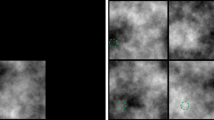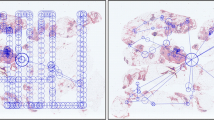Abstract
This study compared a single 8 MP vs. dual 5 MP displays for diagnostic accuracy, reading time, number of times the readers zoomed/panned images, and visual search. Six radiologists viewed 60 mammographic cases, once on each display. A sub-set of 15 cases was viewed in a secondary study using eye-tracking. For viewing time, there was significant difference (F = 13.901, p = 0.0002), with 8 MP taking less time (62.04 vs. 68.99 s). There was no significant difference (F = 0.254, p = 0.6145) in zoom/pan use (1.94 vs. 1.89). Total number of fixations was significantly (F = 4.073, p = 0.0466) lower with 8 MP (134.47 vs. 154.29). Number of times readers scanned between images was significantly fewer (F = 10.305, p = 0.0018) with 8 MP (6.83 vs. 8.22). Time to first fixate lesion did not differ (F = 0.126, p = 0.7240). It did not take any longer to detect the lesion as a function of the display configuration. Total time spent on lesion did not differ (F = 0.097, p = 0.7567) (8.59 vs. 8.39). Overall, the single 8 MP display yielded the same diagnostic accuracy as the dual 5 MP displays. The lower resolution did not appear to influence the readers’ ability to detect and view the lesion details, as the eye-position study showed no differences in time to first fixate or total time on the lesions. Nor did the lower resolution result in significant differences in the amount of zooming and panning that the readers did while viewing the cases.



Similar content being viewed by others
References
Thompson DP, Koller CJ, Eatough JP: Practical assessment of the display performance of radiology workstations. Br J Radiol 80:256–260, 2007
Assessment of display performance for medical imaging systems: executive summary of the AAPM TG18 report. Med Phys 32:1205–1225, 2005
Wade C, Brennan PC: Assessment of monitor conditions for the display of radiological diagnostic images and ambient lighting. Br J Radiol 77:465–471, 2004
Butt A, Mahoney M, Savage NW: The impact of computer display performance on the quality of digital radiographs: a review. Aust Dent J 57:16–23, 2012
Prabhu SP, Gandhi S, Goddard PR: Ergonomics of digital imaging. Br J Radiol 78:582–586, 2005
Krupinski EA, Kallergi M: Choosing a radiology workstation: technical and clinical considerations. Radiology 242:671–682, 2007
Hirschorn DS, Krupinski EA, Flynn MJ: PACS displays: how to select the right display technology. J Am Coll Radiol 11:1270–1276, 2014
Kagadis GC, Walz-Flannigan A, Krupinski EA, Nagy PG, Katsanos K, Diamantopoulos A, Langer SG: Medical imaging displays and their use in image interpretation. RadioGraphics 33:275–290, 2013
Thompson AC, Kremer MJ, Biswal S, Rebner M, Rebner RE, Thomas WR, Edwards SD, Thompson MO, Ikeda DM: Factors associated with repetitive strain, and strategies to reduce injury among breast-imaging radiologists. J Am Coll Radiol 11:1074–1079, 2014
Boiselle PM, Levine D, Horwich PJ, Barbaras L, Siegal D, Shillue K, Affeln D: Repettive stress symptoms in radiology: prevalence and response to ergonomic interventions. J Am Coll Radiol 5:919–923, 2008
Krupinski E, Reiner BI: Real-time occupational stress and fatigue measurement in medical imaging practice. J Digit Imaging 25:319–324, 2012
Reiner BI, Krupinski E: The insidious problem of fatigue in medical imaging practice. J Digit Imaging 25:3–6, 2012
Reiner BI, Krupinski E: Demystifying occupational stress and fatigue through the creation of an adaptive end-user profiling system. J Digit Imaging 25:201–205, 2012
Krupinski EA, Berbaum KS, Caldwell RT, Schartz KM, Kim J: Long radiology workdays reduce detection and accommodation accuracy. J Am Coll Radiol 7:698–704, 2010
Krupinski EA, Berbaum KS, Caldwell RT, Schartz KM, Madsen MT, Kramer DJ: Do long radiology workdays affect nodule detection in dynamic CT interpretation? J Am Coll Radiol 9:191–198, 2012
Taylor-Phillips S, Elze MC, Krupinski EA, Dennick K, Gale AG, Clarke A, Mello-Thoms C: Retrospective review of the drop in observer detection performance over time in lesion-enriched experimental studies. J Digit Imaging 28:32–40, 2015
Dorfman DD, Berbaum KS, Metz CE: Receiver operating characteristic rating analysis: generalization to the population of readers and patients with the jackknife method. Investig Radiol 27:723–731, 1992
Author information
Authors and Affiliations
Corresponding author
Rights and permissions
About this article
Cite this article
Krupinski, E.A. Diagnostic Accuracy and Visual Search Efficiency: Single 8 MP vs. Dual 5 MP Displays. J Digit Imaging 30, 144–147 (2017). https://doi.org/10.1007/s10278-016-9917-6
Published:
Issue Date:
DOI: https://doi.org/10.1007/s10278-016-9917-6




